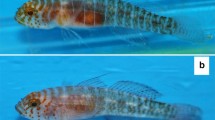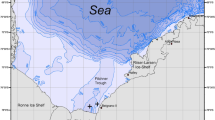Synopsis
The behaviour of free-living pairs ofAequidens vittatus was observed in Surinam, South America. An ethogram of breeding behaviour is presented, based on those observations and on aquarium-held fish. This is a biparental, substrate-guarding species that spawns on a movable platform. Sexual differentiation of parental roles was more pronounced when the young were in the embryonic interval than when they were mobile juveniles. Females spent more time near their brood, attacked juvenile conspecifics more often, and fanned and mouthed embryos more than males did. Males were more involved than females in territorial spacing of pairs. The movable spawning leaf provides support for eggs on detritus substrate and may also provide protection against predators and rapid water level changes.
Similar content being viewed by others
References cited
Barlow, G. W. 1974. Contrasts in social behavior between Central American cichlid fishes and coral-reef surgeon fishes. Amer. Zool. 14: 9–34.
Blumer, L.S. 1979. Male parental care in the bony fishes. Quart. Rev. Biol. 54: 149–161.
Breder, C. M. & D. E. Rosen. 1966. Modes of reproduction in fishes. Nat. Hist. Press, Garden City. 941 pp.
Cichocki, F. 1976. Cladistic history of cichlid fishes and reproductive strategies of the American generaAcarichthys, Biotodoma andGeophagus. Ph.D. thesis, University of Michigan, Ann Arbor. 710 pp.
Cichocki, F. 1977. Tidal cycling and parental behavior of the cichlid fish,Biotodoma cupido. Env. Biol. Fish. 1: 159–169.
Eigenmann, C. H. 1912. The freshwater fishes of British Guiana, including a study of the ecological grouping of species and the relation of the fauna of the plateau to that of the lowlands. Mem. Carneg. Mus. 5: 1–578.
Eigenmann, C. H. & W. R. Allen. 1942. Fishes of Western South America. Univ. Kentucky Press, Lexington. 494 pp.
Fryer, G. & T. D. Iles. 1972. The cichlid fishes of the Great Lakes of Africa. T. F. H. Publishers, Neptune City. 641 pp.
Guimaraes, J. R. A. 1930. O Acara.Geophagus brasiliensis, Quoy et Gaimard. Rev. Indust. Anim. 1: 658–662.
Keenleyside, M. H. A. 1979. Diversity and adaptation in fish behaviour. Zoophysiology, Vol. 11. Springer-Verlag, Heidelberg. 208 pp.
Keenleyside, M. H. A. & C. E. Prince. 1976. Spawning-site selection in relation to parental care of eggs inAequidens paraguayensis (Pisces: Cichlidae). Can. J. Zool., 54: 2135–2139.
Lowe-McConnell, R. H. 1964. The fishes of the Rupununi savanna district of British Guiana, South America. Part 1. Ecological groupings of fish species and effects of the seasonal cycle on the fish. J. Linn. Soc. Lond. Zool. 45: 103–144.
Lowe-McConnell, R. H. 1969. The cichlid fishes of Guyana, South America, with notes on their ecology and breeding behaviour. Zool. J. Linn. Soc. 48: 255–302.
Lüling, K. H. 1971.Aequidens vittatus (Heckel) and andere Fische des Rio Huallaga im Übergangsbereich zur Hylaea. Zool. Beitr. 17: 193–226.
Perrone, M. 1978. Mate size and breeding success in a monogamous cichlid fish. Env. Biol. Fish. 3: 193–201.
Perrone, M. & T. M. Zaret. 1979. Parental care patterns of fishes. Amer. Nat. 113: 351–361.
Regan, C. T. 1905. A revision of the fishes of the SouthAmerican cichlid generaAcara, Nannacara, Acaropsis, andAstronotus. Ann. Mag. Nat. Hist. (ser. 7), 15: 329–347.
Ridley, M. 1978. Paternal care. Anim. Behav. 26: 904–932.
Saul, W. G. 1975. An ecological study of fishes at a site in upper Amazonian Ecuador. Proc. Acad. Nat. Sci., Philad. 127: 93–134.
Smith-Grayton, P. K. & M. H. A. Keenleyside. 1978. Malefemale parental roles inHerotilapia multispinosa (Pisces: Cichlidae). Anim. Behav. 26: 520–526.
Sprenger, K. 1971. The red humpGeophagus. Buntb. Bull. 26: 24–25.
Timms, A. M. & M. H. A. Keenleyside. 1975. The reproductive behaviour ofAequidens paraguayensis (Pisces, Cichlidae). Z. Tierpsychol. 39: 8–23.
Winer, B. J. 1971. Statistical principles in experimental design. 2nd ed. McGraw-Hill, San Francisco. 907 pp.
Author information
Authors and Affiliations
Rights and permissions
About this article
Cite this article
Keenleyside, M.H.A., Bietz, B.F. The reproductive behaviour ofAequidens vittatus (Pisces, Cichlidae) in Surinam, South America. Environ Biol Fish 6, 87–94 (1981). https://doi.org/10.1007/BF00001802
Received:
Accepted:
Issue Date:
DOI: https://doi.org/10.1007/BF00001802




